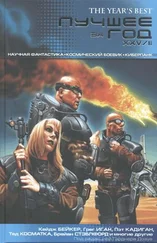Грег Иган - Permutation City
Здесь есть возможность читать онлайн «Грег Иган - Permutation City» весь текст электронной книги совершенно бесплатно (целиком полную версию без сокращений). В некоторых случаях можно слушать аудио, скачать через торрент в формате fb2 и присутствует краткое содержание. Жанр: Фантастика и фэнтези, Киберпанк, на английском языке. Описание произведения, (предисловие) а так же отзывы посетителей доступны на портале библиотеки ЛибКат.
- Название:Permutation City
- Автор:
- Жанр:
- Год:неизвестен
- ISBN:нет данных
- Рейтинг книги:4 / 5. Голосов: 1
-
Избранное:Добавить в избранное
- Отзывы:
-
Ваша оценка:
- 80
- 1
- 2
- 3
- 4
- 5
Permutation City: краткое содержание, описание и аннотация
Предлагаем к чтению аннотацию, описание, краткое содержание или предисловие (зависит от того, что написал сам автор книги «Permutation City»). Если вы не нашли необходимую информацию о книге — напишите в комментариях, мы постараемся отыскать её.
Permutation City — читать онлайн бесплатно полную книгу (весь текст) целиком
Ниже представлен текст книги, разбитый по страницам. Система сохранения места последней прочитанной страницы, позволяет с удобством читать онлайн бесплатно книгу «Permutation City», без необходимости каждый раз заново искать на чём Вы остановились. Поставьте закладку, и сможете в любой момент перейти на страницу, на которой закончили чтение.
Интервал:
Закладка:
Maria slowed down the Autoverse clock by a factor of ten billion, then popped up the viewing menu and hit the button marked RAW. The tidy assembly of spheres and rods melted into a jagged crown of writhing polychromatic liquid metal, waves of color boiling away from the vertices to collide, merge, flow back again, wisps licking out into space.
She slowed down time a further hundredfold, almost freezing the turmoil, and then zoomed in to the same degree. The individual cubic cells which made up the Autoverse were visible now, changing state about once a second. Each cell's "state" -- a whole number between zero and two hundred and fifty-five -- was recomputed every clock cycle, according to a simple set of rules applied to its own previous state, and the states of its closest neighbors in the three-dimensional grid. The cellular automaton which was the Autoverse did nothing whatsoever but apply these rules uniformly to every cell; these were its fundamental "laws of physics." Here, there were no daunting quantum-mechanical equations to struggle with -- just a handful of trivial arithmetic operations, performed on integers. And yet the impossibly crude laws of the Autoverse still managed to give rise to "atoms" and "molecules" with a "chemistry" rich enough to sustain "life."
Maria followed the fate of a cluster of golden cells spreading through the lattice -- the cells themselves didn't move, by definition, but the pattern advanced -- infiltrating and conquering a region of metallic blue, only to be invaded and consumed in turn by a wave of magenta.
If the Autoverse had a "true" appearance, this was it. The palette which assigned a color to each state was still "false" -- still completely arbitrary -- but at least this view revealed the elaborate three-dimensional chess game which underpinned everything else.
Everything except the hardware, the computer itself.
Maria reverted to the standard clock rate, and a macroscopic view of her twenty-one Petri dishes -- just as a message popped up in the foreground:
JSN regrets to advise you that your resources have been diverted to a higher bidder. A snapshot of your task has been preserved in mass storage, and will be available to you when you next log on. Thank you for using our services.
Maria sat and swore angrily for half a minute -- then stopped abruptly, and buried her face in her hands. She shouldn't have been logged on in the first place. It was insane, squandering her savings playing around with mutant A. lamberti -- but she kept on doing it. The Autoverse was so seductive, so hypnotic . . . so addictive.
Whoever had elbowed her off the network had done her a favor -- and she'd even have her fifty-dollar log-on fee refunded, since she'd been thrown right out, not merely slowed down to a snail's pace.
Curious to discover the identity of her unintentional benefactor, she logged on directly to the QIPS Exchange -- the marketplace where processing power was bought and sold. The connection to JSN had passed through the Exchange, transparently; her terminal was programmed to bid at the market rate automatically, up to a certain ceiling. Right now, though, some outfit calling itself Operation Butterfly was buying QIPS -- quadrillions of instructions per second -- at six hundred times that ceiling, and had managed to acquire one hundred percent of the planet's traded computing power.
Maria was stunned; she'd never seen anything like it. The pie chart of successful bidders -- normally a flickering kaleidoscope of thousands of needle-thin slices -- was a solid, static disk of blue. Aircraft would not be dropping out of the sky, world commerce would not have ground to a halt . . . but tens of thousands of academic and industrial researchers relied on the Exchange every day for tasks it wasn't worth owning the power to perform in-house. Not to mention a few thousand Copies. For one user to muscle in and outbid everyone else was unprecedented. Who needed that much computing power? Big business, big science, the military? All had their own private hardware -- usually in excess of their requirements. If they traded at all, it was to sell their surplus capacity.
Operation Butterfly? The name sounded vaguely familiar. Maria logged on to a news system and searched for reports which mentioned the phrase. The most recent was three months ago:
Kuala Lumpar -- Monday, August 8th, 2050: A meeting of environmental ministers from the Association of South-East Asian Nations (ASEAN) today agreed to proceed with the latest stage of Operation Butterfly, a controversial plan to attempt to limit the damage and loss of life caused by Greenhouse Typhoons in the region.
The long-term aim of the project is to utilize the so-called Butterfly Effect to divert typhoons away from vulnerable populated areas -- or perhaps prevent them from forming in the first place.
Maria said, "Define 'Butterfly Effect.'" A second window opened up in front of the news report:
Butterfly Effect: This term was coined by meteorologist Edward Lorenz in the late 1970s, to dramatize the futility of trying to make long-term weather forecasts. Lorenz pointed out that meteorological systems were so sensitive to their initial conditions that a butterfly flapping its wings in Brazil could be enough to determine whether or not there was a tornado in Texas a month later. No computer model could ever include such minute details -- so any attempt to forecast the weather more than a few days in advance was doomed to failure.
However, in the 1990s the term began to lose its original, pessimistic connotations. A number of researchers discovered that, although the effects of small, random influences made a chaotic system unpredictable, under certain conditions the same sensitivity could be deliberately exploited to steer the system in a chosen direction. The same kind of processes which magnified the flapping of butterflies' wings into tornadoes could also magnify the effects of systematic intervention, allowing a degree of control out of all proportion to the energy expended.
The Butterfly Effect now commonly refers to the principle of controlling a chaotic system with minimum force, through a detailed knowledge of its dynamics. This technique has been applied in a number of fields, including chemical engineering, stock-market manipulation, fly-by-wire aeronautics, and the proposed ASEAN weather-control system, Operation Butterfly.
There was more, but Maria took the cue and switched back to the article.
Meteorologists envisage dotting the waters of the tropical western Pacific and the South China Sea with a grid of hundreds of thousands of "weather-control" rigs -- solar-powered devices designed to alter the local temperature on demand by pumping water between different depths. Theoretical models suggest that a sufficient number of rigs, under elaborate computer control, could be used to influence large-scale weather patterns, "nudging" them toward the least harmful of a number of finely balanced possible outcomes.
Eight different rig prototypes have been tested in the open ocean, but before engineers select one design for mass production, an extensive feasibility study will be conducted. Over a three-year period, any potentially threatening typhoon will be analyzed by a computer model of the highest possible resolution, and the effects of various numbers and types of the as yet nonexistent rigs will be included in the model. If these simulations demonstrate that intervention could have yielded significant savings in life and property, ASEAN's ministerial council will have to decide whether or not to spend the estimated sixty billion dollars required to make the system a reality. Other nations are observing the experiment with interest.
Читать дальшеИнтервал:
Закладка:
Похожие книги на «Permutation City»
Представляем Вашему вниманию похожие книги на «Permutation City» списком для выбора. Мы отобрали схожую по названию и смыслу литературу в надежде предоставить читателям больше вариантов отыскать новые, интересные, ещё непрочитанные произведения.
Обсуждение, отзывы о книге «Permutation City» и просто собственные мнения читателей. Оставьте ваши комментарии, напишите, что Вы думаете о произведении, его смысле или главных героях. Укажите что конкретно понравилось, а что нет, и почему Вы так считаете.









![Грег Иган - Рассказы [компиляция]](/books/419837/greg-igan-rasskazy-kompilyaciya-thumb.webp)
